Silver fillings, known as Amalgam, are commonly used to fix dental cavities. They are very common and have plenty of implications for restoring damaged and broken teeth. For example, silver fillings are sturdy, durable, and cost-effective. However, silver fillings contain mercury. Mercury is a heavy metal that is a known toxin. Now it's debatable whether or not the mercury content in silver fillings is harmful to your health. Some dentists argue that silver fillings are perfectly safe since you're not actually ingesting the mercury inside. Other dentists strictly oppose the use of Amalgam due to its potential health hazards. In fact, many cosmetic dentists don't even offer silver filling as a treatment option in their dental practices.
Regardless of your stance on the safety of Amalgam, you might find yourself in a position wanting to replace your silver fillings with white ones. Before you do this, you should understand the risks and benefits of Amalgam fillings. You should also understand the process of what it takes to replace silver fillings with white ones. Let's take a closer look so that you can make a more informed decision.
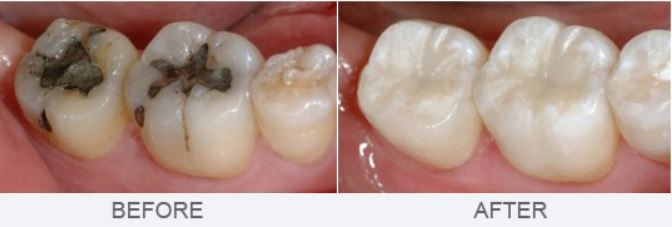
Most patients who replace their silver fillings with white fillings due so because of the mercury content in silver fillings
Benefits of Replacing Silver Fillings
There are plenty of situations where you have to replace your silver fillings. You can choose to replace the filling with a new silver filling or you may opt to go for a white filling instead. Let's take a closer look at the benefits of replacing silver fillings with white ones to see if it makes sense:
Health Concerns Over Mercury
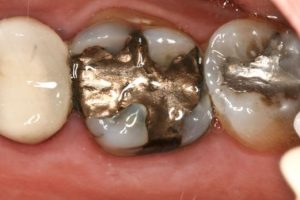
All amalgam fillings contain a high percentage of mercury. The mercury is essential to strengthening the silver filling and making it durable and sturdy. However, mercury is a heavy metal that is toxic if ingested. Ingesting high levels of mercury produces mercury toxicity which has the following symptoms:
- Speech, vision, or hearing impairment
- Disturbed sensation
- Lack of coordination
Despite the dangers of mercury, there's no concrete evidence that the mercury contained inside silver fillings causes major ailments. Obviously, you don't want to digest too much of this material. However, it's undetermined if the mercury inside silver fillings is harmful to your health or not. Ultimately, it's your decision whether or not you're okay with having mercury inside your mouth. If you're worried about the safety of mercury or convinced that your silver fillings are adversely affecting your health, then you should consider replacing your silver fillings.
Superior Aesthetics
Another reason why people replace their silver fillings is for improved aesthetics. Silver fillings are not as attractive as white ones. Having lots of large silver fillings inside your mouth gives you a metal-mouth appearance. Your silver fillings show up when you're talking, smiling, and taking photos. Replacing older silver fillings with white ones enhances your smile and improves your self-confidence.
Replacing Damaged Old Fillings
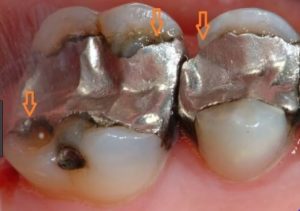
An example of an old Amalgam filling that requires replacement because it is cracked and decayed
The final reason to replace your silver fillings is that it's just time to replace the filling. Silver fillings are quite durable, however, they still require replacement after so many years. Old silver fillings that are cracked and decayed need to be replaced as soon as possible. It might not be a bad idea to consider replacing your old Amalgam fillings with more aesthetic and holistic white fillings.
Risks of Amalgam Removal
So far it sounds like there are plenty of benefits to replacing your silver fillings with white ones. However, there are certain risks that you need to be aware of before deciding to do this procedure. Let's take a closer look at the major complications involved with replacing silver fillings with white fillings:
Developing Tooth Sensitivity
Replacing your silver fillings with white ones may lead to tooth sensitivity. Every time an old filling is removed and replaced, there's a chance that your tooth becomes sensitive. The larger your silver filling, the higher your risk of developing tooth sensitivity afterward. Luckily, this tooth sensitivity is usually temporary and resolves itself within a few weeks, or maybe a month or two. However, sometimes this tooth sensitivity ends up being irreversible. Therefore, you should be very cautious when making the decision to replace your silver fillings. Especially if you already have tooth sensitivity or if you have large fillings in your mouth.
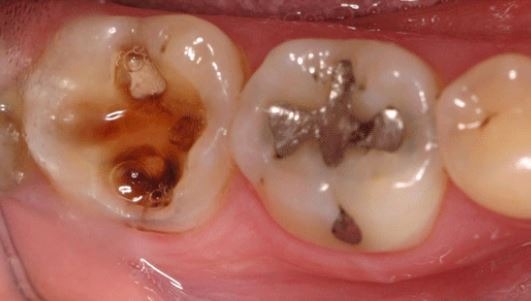
The larger your silver filling, the higher your risk of developing tooth sensitivity after replacing the filling
Possibility of Needing a Crown or Root Canal
Whenever your dentist works on a tooth, there's the small possibility of needing additional treatment. This means that occasionally your replacement filling becomes painful. In these cases, you may have to place a crown on the tooth. In the worst-case scenario, you develop a lingering toothache that won't resolve with time. Unfortunately, this means that your tooth requires a root canal treatment. What started out as a simple Amalgam replacement could end up being a much, much bigger problem!
Costs
Replacing one silver filling with a white filling isn't going to break the bank. However, if you have a whole mouth full of silver fillings, it can be quite expensive to replace all of them. There is the initial cost of replacing your silver fillings. Additionally, there's the possibility that not all of your silver fillings can be replaced with another filling. Very large silver fillings have to be replaced with inlays, onlays, or crowns instead of white fillings. As a result, the costs of replacing all of your Amalgam fillings can easily add up to several thousand dollars.
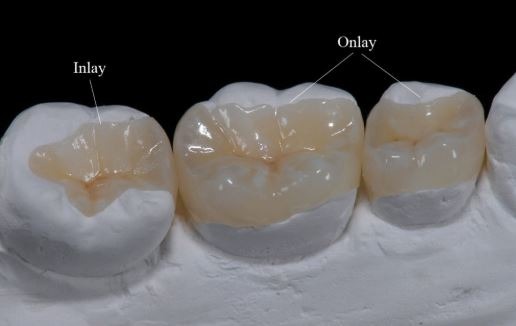
Inlays and onlays are stronger than white fillings and a better option for replacing large Amalgam fillings
Does dental insurance cover Amalgam replacement with white fillings?
As you're probably aware, dental insurance only covers medically necessary treatments. Replacing silver fillings for health concerns is not a medical necessity and won't be covered by your dental insurance. Similarly, replacing silver fillings to improve the appearance of your smile is not a covered procedure either. The vast majority of dental insurance companies only cover white fillings on the front teeth. This means that you're going to be responsible for an upgrade fee for placing white fillings on the back teeth. The only time dental insurance covers Amalgam replacement is when the filling breaks or develops a cavity. Again, be ready to pay an upgrade fee if you choose a white filling over an Amalgam. White fillings are more expensive and take longer to perform. Therefore, almost all dentists charge additional for white fillings as compared to silver. Is it worth it? That's a decision you have to make. At least by now, you have full knowledge of all the benefits and risks of replacing your silver fillings with white ones.

Dental insurance does not cover the replacement of silver fillings over health concerns or for cosmetic enhancement
0 Comments